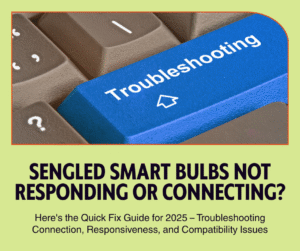As an Amazon Associate, we may earn a commission if you make a purchase — at no extra cost to you.
Best Smart Bulbs for Home Office Productivity
Discover the best smart bulbs for home office productivity. Boost focus, reduce eye strain, and create the perfect lighting for work and relaxation.
Lighting can make a big difference in how people feel and work in their home office. Smart bulbs offer more control over brightness and color, helping users stay focused and comfortable throughout the day. The right smart bulb can help reduce eye strain, boost mood, and even support better sleep patterns after work.
💡 Why You’ll Want to Read This Smart Bulb Guide
Updated in 2025 with the latest bulbs optimized for productivity, this guide highlights smart lighting solutions that reduce eye strain, improve focus, and sync with your home office workflow. Learn which bulbs deliver on real‑world performance, app control, and energy efficiency.
🎯 What You’ll Walk Away With
- ✅ Best smart bulbs for enhancing productivity, focus, and comfort
- ✅ Color temperatures, lumens, and brightness settings ideal for home offices
- ✅ Voice, hub, and app control options tailored for busy remote workers
- ✅ Side-by-side reviews of top brands like Philips Hue, WiZ, Tapo, and LIFX

Choosing a smart bulb for a home office means looking at features like easy app controls, compatibility with voice assistants, and adjustable lighting settings. The top options today are easy to install and can change how a space feels with just a few taps on a smartphone.
Key Takeaways
- Smart bulbs can improve comfort and productivity in a home office.
- Important features include adjustable brightness and voice control.
- The best smart bulbs are simple to set up and use.
Why Smart Bulbs Boost Home Office Productivity
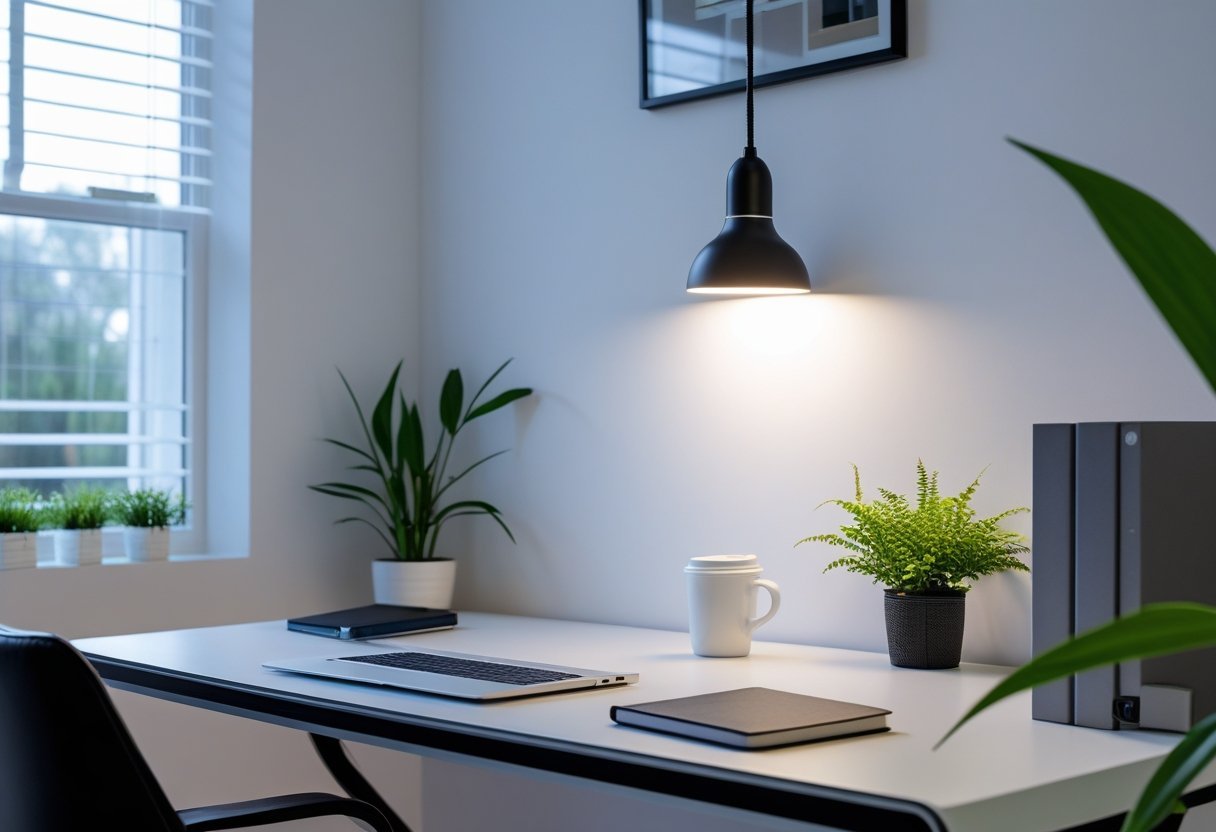
Smart bulbs offer flexible brightness, energy savings, and easy control from a phone or voice assistant. They can match a user’s schedule, adjust to different tasks, and connect with other smart devices for extra convenience.
Lighting Hacks: Improve Focus & Reduce Eye Strain
Proper lighting helps reduce eye strain during long work hours. Smart bulbs let users change brightness and color temperature to suit different tasks. For example, a cool white setting may help with focus in the morning, while a warmer tone can create a relaxed mood for late-day work.
Many smart bulbs offer preset modes for reading, concentrating, or relaxing. These can be accessed using an app or voice command. By adjusting the light to match the activity, people may experience less fatigue and better concentration.
Short breaks with dimmed light can help rest the eyes, while brighter settings are useful for video calls. Custom schedules keep the workspace well-lit throughout the day, supporting a consistent routine.
Save Energy and Cut Costs With Smart Bulbs
Smart bulbs use LED technology, which requires less power than regular incandescent bulbs. This can lower electricity bills over time. Many models offer features like automatic shut-off and dimming when the room is empty.
With scheduling options, lights can turn off after work hours, reducing wasted energy. Smart bulbs typically last longer than traditional bulbs—often up to 15,000-25,000 hours. This means users buy replacements less often.
A table can show the difference in energy use:
| Bulb Type | Lifespan (hours) | Energy (watts) | Estimated Cost (per year) |
|---|---|---|---|
| Incandescent | 1,000 | 60 | $8–$11 |
| LED Smart Bulb | 15,000–25,000 | 8–10 | $1–$2 |
Personalize Your Lighting With Smart Bulbs
Smart bulbs let users set up lighting routines to match their work habits. Lights can be scheduled to turn on before the workday starts or fade out after finishing. Users can choose from millions of colors and a wide range of brightness levels.
Customization options include:
- Setting light color for meetings or focused tasks
- Adjusting brightness for reading or screen time
- Choosing scenes for breaks or brainstorming sessions
All adjustments can be made through an app, remote, or voice assistant. This means users don’t need to interrupt their workflow to change settings. Some models also support grouping, so entire rooms can be controlled with one command.
Seamless Smart Home Integration & Voice Control
Many smart bulbs work with popular platforms like Amazon Alexa, Google Home, or Apple HomeKit. This integration allows users to control lights with just their voice or connect them with other smart devices in their home office.
For example, lights can turn on automatically when someone enters the room using motion sensors. They can also sync with calendars, so the light changes before a meeting or reminders.
Some bulbs support routines that include other devices, such as adjusting lights and playing soft background music for focused work. Integration makes it easy to manage all smart devices from one place, adding convenience to daily tasks.
How to Choose the Best Smart Bulbs for Your Home Office
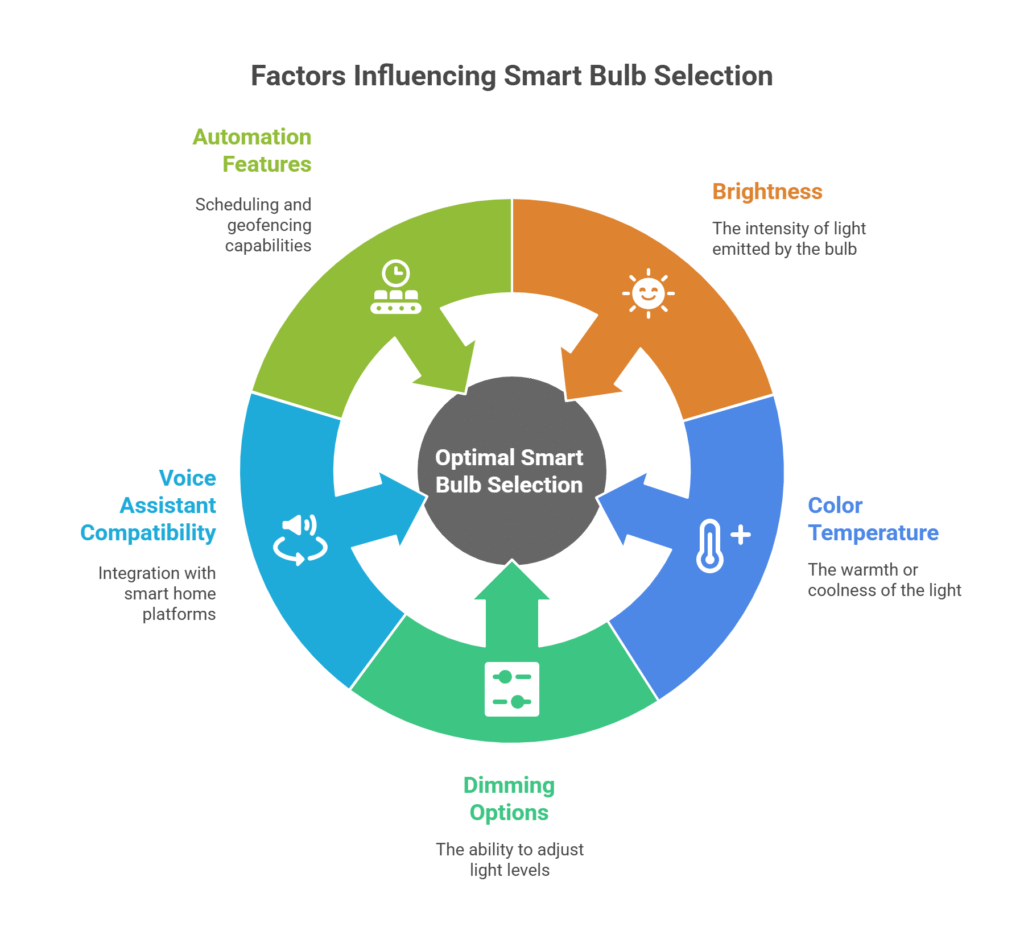
Smart bulbs come with many features that can directly affect comfort, productivity, and convenience in a home office. Knowing which details matter helps users pick the best option for their specific needs.
Brightness & Color Temperature: What Matters Most
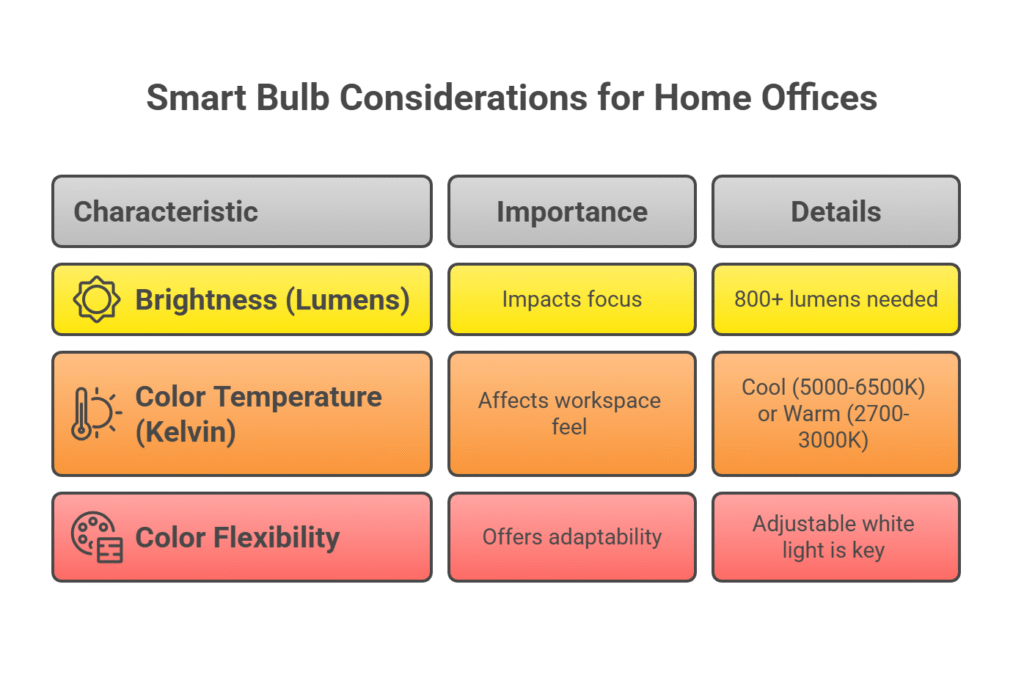
The brightness of a smart bulb, measured in lumens, impacts how well a person can see and focus. Home offices usually need bulbs with at least 800 lumens, similar to a traditional 60-watt bulb. For spaces with less natural light, higher brightness may be better.
Color temperature changes the look and feel of the workspace. Measured in Kelvin (K), lower numbers (2700–3000K) give off a warmer, yellow light, while higher numbers (5000–6500K) give a cooler, blue-white light. Cooler temperatures are often better for tasks that need focus, while warmer tones are good for relaxing.
Some smart bulbs let users choose from millions of colors, but adjusting white light is most important for office work. Bulbs that can switch between cool and warm light offer more flexibility, making it easier to create the right work environment.
Smooth Dimming for Work Comfort
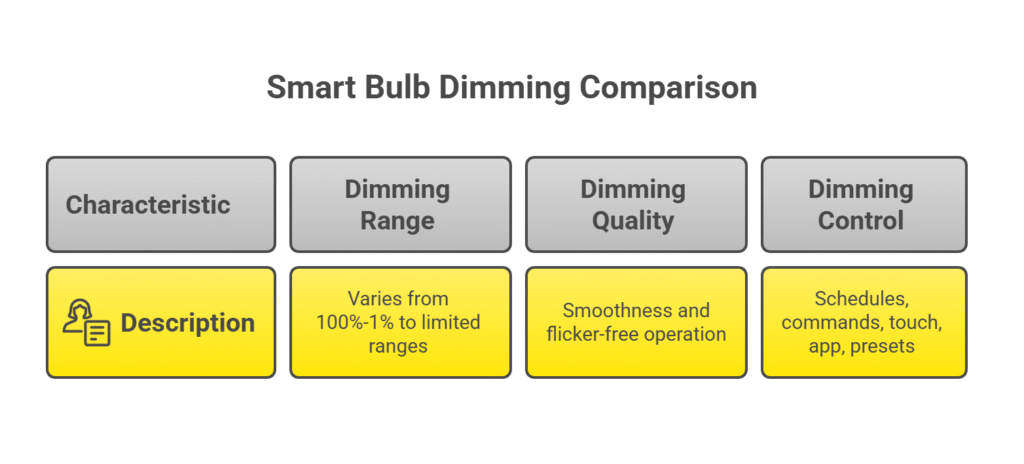
Dimming options help control light levels throughout the day. Not all smart bulbs dim in the same way—some can go from 100% down to 1%, while others have limited dimming ranges. Deep dimming is helpful for early mornings, late nights, or video calls when harsh light is not needed.
Dimming should be smooth and flicker-free. Flickering can cause eye strain or headaches over time. Check if the bulb supports fine-grained dimming or only basic steps, as this affects comfort and usability.
Some bulbs allow users to set dimming schedules or use commands to change light levels. Touch controls, app controls, or preset scenes can make dimming more convenient.
Voice Assistant Features: Alexa, Google & More
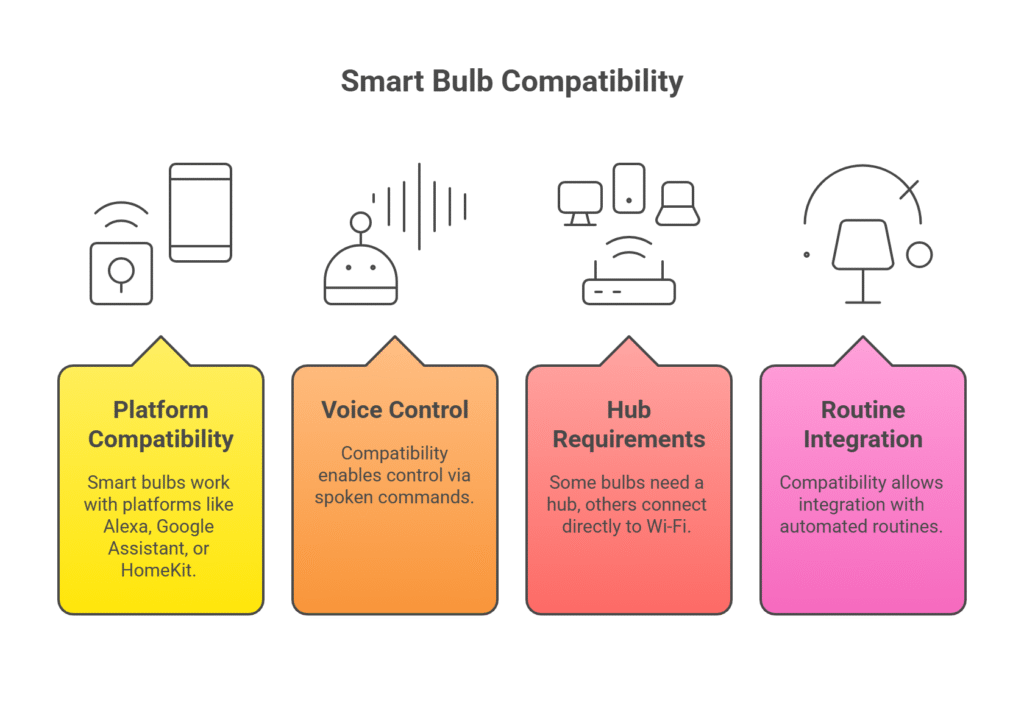
Most smart bulbs work with at least one smart home platform, such as Amazon Alexa, Google Assistant, or Apple HomeKit. Compatibility lets users control lights with spoken commands, making it easy to turn bulbs on or off, change brightness, or adjust color without using a phone or switch.
To avoid frustration, check if the bulb works out of the box with the chosen voice assistant. Some bulbs require an extra hub for full features, while others connect directly to Wi-Fi.
Integration with routines—like “Good Morning” or “Work Mode”—also depends on compatibility. This makes it easier to automate lighting as part of daily habits.
Automate Your Lighting Routine

Scheduling lets users set times for the bulbs to turn on or off automatically. For example, the lights can come on right before the workday starts and turn off after hours. This helps save energy and ensures the workspace is always ready.
Automation features can adjust lighting based on conditions such as the time of day or even the weather. Some platforms allow detailed routines, like dimming lights in the evening or switching to a cool white in the afternoon.
Regular schedules and smart automation can improve productivity by creating signals for when it’s time to focus or take a break. Some smart bulb brands also support geofencing, which turns lights on or off when a person enters or leaves the room.
Top-Rated Smart Bulbs to Light Up Your Home Office

Smart bulbs can improve the work-from-home experience with features like adjustable brightness, voice control, and energy savings. Choosing the right bulb depends on budget, color options, and eco-friendliness.
Best Overall Smart Bulb for Any Office
Philips Hue White and Color Ambiance is often considered the best overall choice. It stands out for its strong compatibility, reliable connectivity, and easy integration with leading smart home systems, such as Amazon Alexa, Google Assistant, and Apple HomeKit.
The Hue bulb supports millions of colors and a wide range of white tones. Users can automate lighting schedules and set up different scenes for meetings, focus, or relaxation. The mobile app is simple, with clear controls for brightness and color changes.
These bulbs use only about 8.5 watts and last up to 25,000 hours. The initial cost is higher than most, but many find the build quality and consistent performance worth the investment.
Key Features:
- Compatible with most smart platforms
- Easy-to-use app
- Custom color and schedule options
- Long lifespan
- WHAT’S IN THE BOX - Includes three White and Color Ambiance smart 60W-equivalent A19...
- UNLOCK THE FULL POWER OF HUE - Add a Hue Bridge to enjoy automations, control from anywhere in the...
- MILLIONS OF COLORS - The White & Color Ambiance range offers both warm-to-cool white and millions of...
Last update on 2025-11-12 / Affiliate links / Images from Amazon Product Advertising API
Best Budget-Friendly Smart Bulb Pick
Wyze Bulb Color delivers notable smart features at a low price. It connects directly to Wi-Fi, so there’s no need for a separate hub. This makes setup fast and simple, even for first-time users.
The Wyze Bulb Color supports both white and color lighting, with adjustable brightness levels. It works with Alexa and Google Assistant, offering basic voice controls like turning the bulb on or off, dimming, and changing colors.
Energy use is moderate, at about 9.5 watts per bulb. While some features in the app are less advanced than pricey brands, the value for money and solid performance make it popular for home office lighting on a budget.
Key Features:
- Hub-free setup
- Broad color selection
- Affordable pricing
- Compatible with Alexa and Google Assistant
- Brighter. Dimmer. Better. - Most color bulbs max out at 800lm. Tune ours brighter (1100lm/75W),...
- 16 Million Colors - Whether it’s game day or wine night, precise color control in the Wyze app...
- White Light Temperature Control - Cool it down and focus or warm it up and relax. Dedicated white...
Last update on 2025-11-12 / Affiliate links / Images from Amazon Product Advertising API
Best Smart Bulb for Rich Color Options
LIFX Color A19 offers a rich range of colors and strong brightness. The bulb provides over 16 million color options and can generate multiple shades of white light, from soft warm to cool daylight.
No hub is required, and it connects straight to Wi-Fi. The LIFX app is user-friendly, letting users set schedules, group bulbs, and adjust both color and brightness quickly. Features like “Day & Dusk” automation help tailor light settings for productivity or relaxation throughout the day.
With support for Alexa, Google Assistant, and Apple HomeKit, it fits into many smart home setups. Though it uses about 9 watts, the bulb is one of the brightest available.
Key Features:
- 16 million colors
- High brightness
- Works with most smart assistants
- No hub needed
- 1100 lumens: Ultra bright! But also dimmable via voice or app.
- Full color: 550 billion possible color steps. RGBW LEDs for richer colors and huge 1500-9000K white...
- Iconic industrial design: unique shape maintains whole room light distribution, and looks great in...
Last update on 2025-11-12 / Affiliate links / Images from Amazon Product Advertising API
Best Eco-Friendly Smart Bulb for Green Offices
Sengled Smart LED is known for its low energy use and long life. It draws only about 9 watts per bulb, making it one of the most energy-efficient options. The bulb is mercury-free and uses recyclable packaging.
Sengled bulbs work with Alexa, Google Assistant, and SmartThings. The setup is usually straightforward, though some features need a hub. The Sengled app offers dimming, scheduling, and grouping options so users can further reduce power by only lighting the spaces they need.
With a rated life of about 25,000 hours, this bulb minimizes the need for replacement. It meets strict energy standards, helping reduce the carbon impact of home office lighting.
Key Features:
- Low energy use
- Long lifespan
- Recyclable materials and packaging
- Compatible with popular smart platforms
- Matter-certified, Enhanced Compatibility: Easily controlled via voice command or mobile app Google...
- Bright and Energy Efficient: 800 Lumens makes it brighter than many bulbs with the same wattage, but...
- HANDS-FREE VOICE OR APP CONTROL: Conveniently use voice commands or mobile app to easily control the...
Last update on 2025-11-12 / Affiliate links / Images from Amazon Product Advertising API
Smart Bulb Comparison Matrix – Top 5 Picks (2025)
The matrix below compares five leading smart bulbs ideal for home office productivity. We took the top products mentioned in our guide – Philips Hue, Wyze, LIFX, Sengled – and added TP-Link’s Tapo bulb as a newly trending 2025 model (Matter-supported). Each bulb is evaluated on crucial criteria for a home office consumer. (Ratings are on a 1–5 scale, where 5 = best in class for that criterion.)
| Criteria | Philips Hue White & Color Ambiance |
Wyze Bulb Color | LIFX Color A19 | Sengled Smart LED (Matter A19) |
TP-Link Tapo (Matter A19) |
|---|---|---|---|---|---|
| Brightness (Lumens) |
★★★★☆ – ~800 lm (60W eq) | ★★★★★ – 1100 lm (very bright) | ★★★★★ – 1100 lm (very bright) | ★★★★☆ – 800 lm (standard) | ★★★★★ – 1100 lm (very bright) |
| Color Range (White Tuning & Colors) |
★★★★☆ – 16M colors; whites ~2000K–6500K | ★★★★★ – 16M colors; 1800K–6500K | ★★★★★ – 16M colors; 1500K–9000K | ★★★☆☆ – 16M colors; 2700K–6500K | ★★★★☆ – 16M colors; 2500K–6500K |
| Smart Integration (Voice & Platform) |
★★★★★ – Alexa, Google, Apple HomeKit | ★★★☆☆ – Alexa & Google only | ★★★★★ – Alexa, Google, HomeKit | ★★★★★ – Matter (All platforms) | ★★★★★ – Matter (Universal) |
| Ease of Setup & Use | ★★★★☆ – Easy via Bluetooth or Hue Bridge | ★★★★★ – Wi-Fi setup; no hub Works instantly with voice |
★★★★☆ – App rich but slightly technical | ★★★★☆ – Easy QR scan via Matter | ★★★★★ – Quick Matter pairing |
| Value for Money | ★★★☆☆ – High price (~$40+ bulb) + hub cost |
★★★★★ – Budget ($10 in packs) | ★★★★☆ – Mid-high (~$35) but no hub | ★★★★☆ – Affordable (~$12–$20) Low energy use |
★★★★★ – Great price (~$11) |
Table: Comparison of top smart bulbs for home office productivity. Each product is rated (1–5) on key criteria. Higher scores indicate a better fit for home office needs. Philips Hue excels in quality and integration, but its cost lowers its value score. Wyze and Tapo shine as budget-friendly options with high brightness. LIFX offers top-tier brightness and color flexibility. Sengled’s Matter bulb scores high on compatibility and eco-friendliness (low power, long lifespan), with a standard brightness output.
Sources: Lumens and color temperature specs are from official product data (e.g., Wyze 1100 lm and 1800–6500K rangesupport.wyze.com, LIFX 1100 lm and 1500–9000K whiteslifx.com). Integration ratings consider platform support: Hue and LIFX support all major smart assistantspcworld.comhomedepot.com, whereas Wyze lacks Apple HomeKit/Matterpcworld.com. Both Sengled and Tapo are Matter-enabled, meaning they work with Alexa, Google, and Apple systems interchangeably. Ease-of-use notes reflect setup methods (Hue’s Bridge vs. others’ Wi-Fi or Matter setup)matteralpha.com.
Figure: Radar chart visualizing the comparison. Each axis represents a criterion (brightness, color range, integration, ease of use, value), and the colored lines show each bulb’s score (higher outwards is better). This gives a quick graphical snapshot of how each product excels or falls short across the five criteria.
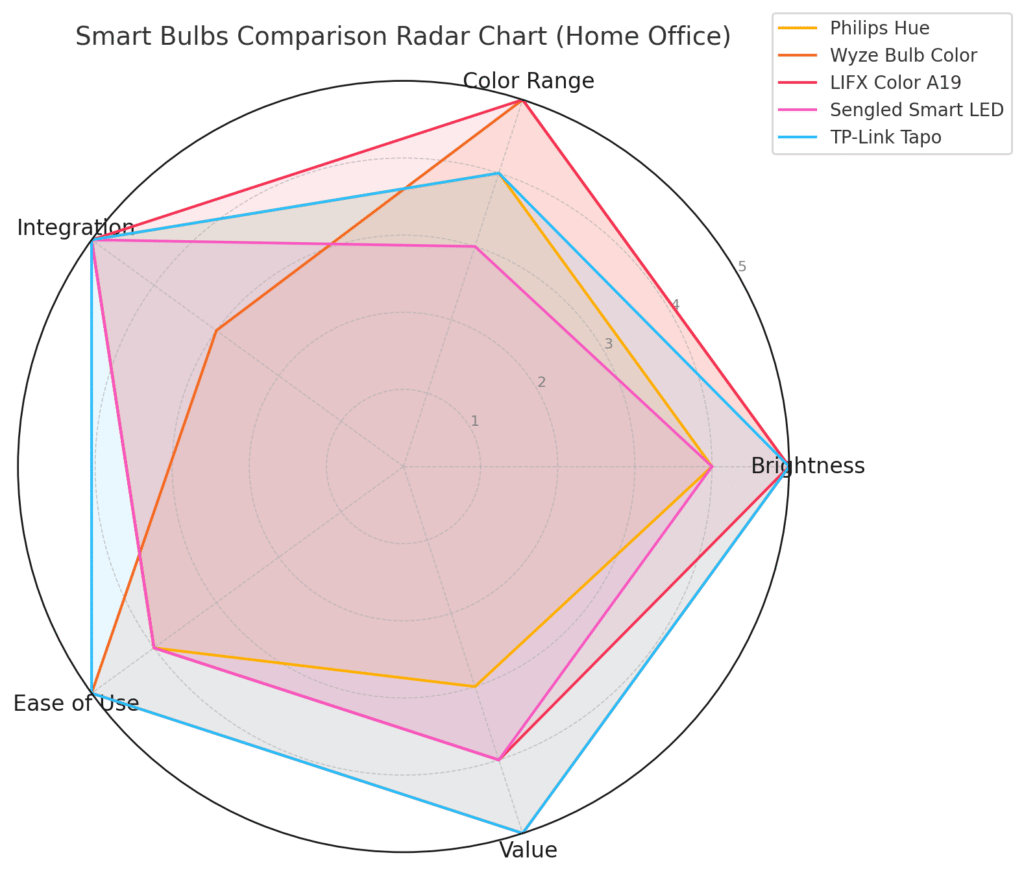
Easy Installation & Setup Guide for Smart Bulbs
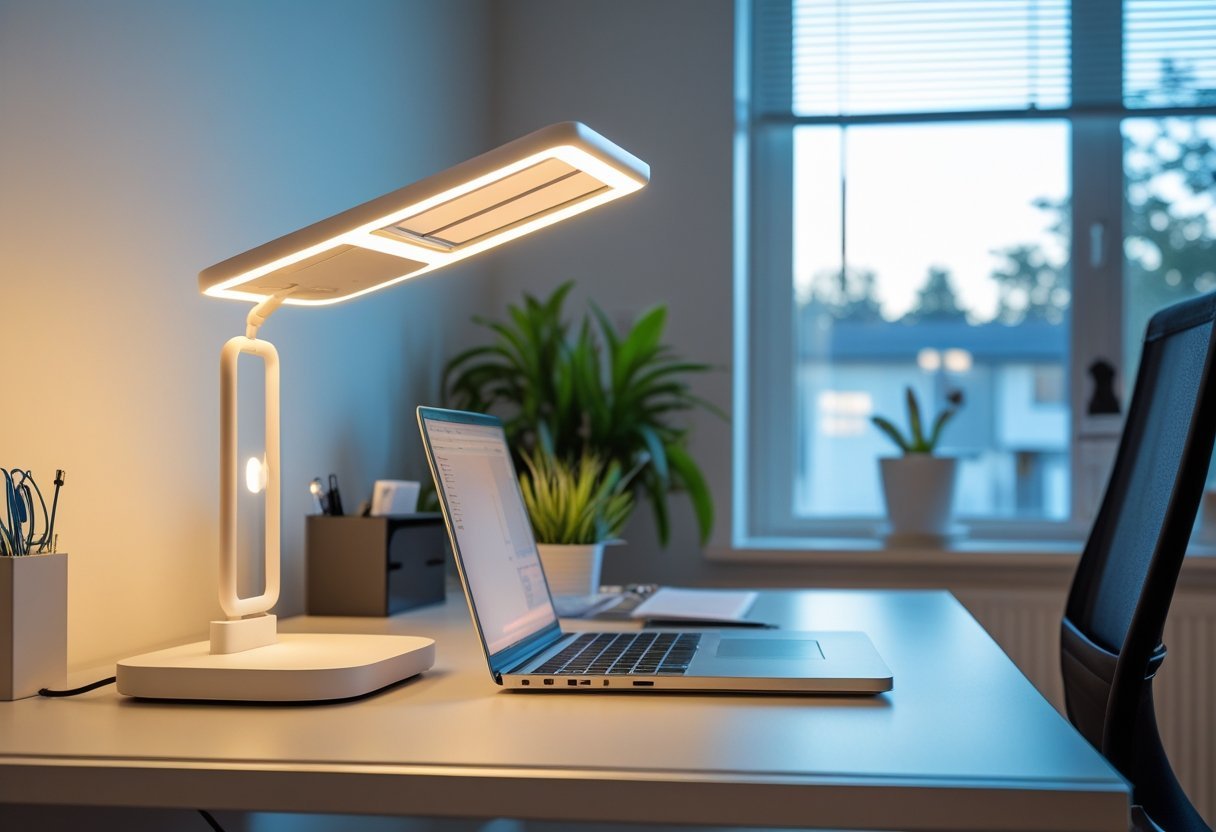
Smart bulbs are easy to use, but setup steps can vary. It’s important to check your fixtures, connect the bulbs properly, and follow clear instructions for configuration.
Fixture Compatibility: Will the Bulb Fit?
Not every smart bulb fits every light fixture. Most smart bulbs come in standard sizes such as A19 or BR30, which work with common desk lamps and ceiling fixtures. However, some older or specialty lamps may need a different size or base type.
Bulbs labeled E26 (medium base) are typical for North American homes. Those with smaller sockets may require E12 (candelabra). Always check the bulb’s shape, base, and maximum wattage for your light fixture. Avoid placing smart bulbs in fully enclosed fixtures unless the manufacturer says it’s safe, as this can cause overheating.
Table: Common Base Types and Fixtures
| Base Type | Description | Common Fixtures |
|---|---|---|
| E26 | Medium Screw Base | Desk, Ceiling |
| E12 | Candelabra | Chandeliers |
| GU10 | Twist-Lock | Track Lighting |
Check product details for dimmable fixtures. Not all smart bulbs support dimmers or 3-way switches.
How to Connect Your Smart Bulb to Wi-Fi or Bluetooth
Most smart bulbs use Wi-Fi or Bluetooth. Before installation, make sure the home Wi-Fi network is working and has a strong signal in the office area. If using Bluetooth, keep the phone or tablet nearby during setup.
To connect, screw in the bulb, turn on the power, and open the manufacturer’s app. Many bulbs begin blinking, showing they’re ready to pair. Follow the app’s prompts for Wi-Fi, often entering a password, or select the bulb from a list for Bluetooth models.
Some smart bulbs require a hub (like Philips Hue). Check if a separate device is needed before buying. Always note if your smart home system is Apple HomeKit, Alexa, or Google Assistant compatible, as some only work with certain platforms.
Quick Setup & Configuration Tips for Beginners
After pairing the bulb, give it a clear name in the app for easy control later (e.g., “desk lamp” or “ceiling light”). Set up any scenes or routines for your workday, such as “morning boost” or “focus mode,” by adjusting brightness and color temperature.
Test voice controls if the bulb supports Alexa, Google, or Siri. Try simple commands like “turn on office light” or “set lamp to 50%.” Update the bulb’s firmware through the app if prompted, as updates can fix bugs and add features.
For best results, save your preferred settings and check for scheduled updates in the app. Use the support section in the app or online if setup doesn’t work as expected. Keep instructions nearby in case you need to reconfigure the bulb later.
💡 Frequently Asked Questions
🟡 What is the best color temperature for a home office smart bulb?
The best color temperature for home office lighting is between 4000K and 5000K for daytime focus. Switch to 2700K–3000K for a warmer evening feel to reduce eye strain and prepare for sleep.
🟢 Can I use smart bulbs without a hub in my home office?
Absolutely! Choose a smart bulb without hub for home office like Wyze or LIFX for simple Wi-Fi setup and app or voice control. No extra hardware needed.
🔵 What’s the ideal brightness level for a home office smart bulb?
The ideal home office smart bulb brightness is 800–1100 lumens, depending on your natural light and task intensity. Go higher for larger or darker rooms.
🟠 Do smart bulbs help reduce eye strain during long work hours?
Yes! Use reduce eye strain smart lighting settings like dimming and warm color modes during breaks to relax your eyes and stay comfortable during long sessions.
🟣 Are there smart bulbs that support schedules and automation?
Definitely. Look for bulbs with strong smart bulb scheduling features to automate on/off times and light levels based on your work habits or time of day.
🟤 Which smart bulb is best for eco-conscious home offices?
For sustainability, try the eco friendly smart bulb for home like Sengled LED. It uses less energy, lasts longer, and supports recyclable packaging.






